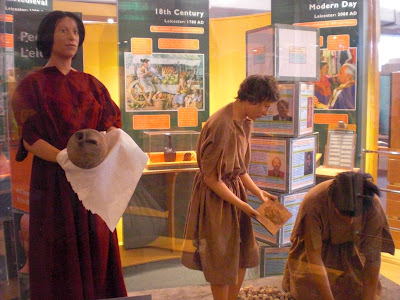What to do with historic displays?
Do they have a place, a role to play, in contemporary museums? Should museums publicly reflect upon their own histories and how? Are audiences really interested? Do only museologists care?!
These questions have been bothering me since our PhD community Hallowe'en Museum Crawl round Leicester (podcast/photos coming soon!). Focused particularly upon a group of beautifully crafted, yet hopelessly outdated dioramas displayed at Jewry Wall Museum, Leicester's criminally neglected archaeology museum.

The dioramas were made for the 1951 Festival of Britain and thereafter bought by Leicester Museum Service. They depict family groups from the prehistoric to Anglo-Saxon periods of English history.


Until recently, the cases housing the dioramas were seemingly indiscriminately dotted about the museum wherever there was an empty space, kind of as an afterthought. They certainly did not belong to adjacent displays, their presence - silent, yet obtrusive - ruptured the otherwise chronological narrative (a similar fate still befalls several just as elderly figures representing characters from Chaucer's Canterbury Tales).

However recently they have been reincorporated into the display as key didactic objects. A new label does admit their 'shortcomings', that ideas about these historical periods has developed over the intervening decades. And yet, even if it is not the intention, the figure groups otherwise inhabit the gallery space unchallenged. To the average visitor there is no reason to doubt their veracity, their objectivity, their scientific basis in reality. Indeed, the museum has recently commissioned a new figure group depicting Roman craftsmen laying a mosaic floor. Highly problematic.



But they are beautiful and fascinating for what they reveal of archaeological knowledge and museum practice 60 years ago. They deserve to be exhibited.
Do you see the paradox?
These questions have been bothering me since our PhD community Hallowe'en Museum Crawl round Leicester (podcast/photos coming soon!). Focused particularly upon a group of beautifully crafted, yet hopelessly outdated dioramas displayed at Jewry Wall Museum, Leicester's criminally neglected archaeology museum.

The dioramas were made for the 1951 Festival of Britain and thereafter bought by Leicester Museum Service. They depict family groups from the prehistoric to Anglo-Saxon periods of English history.


Until recently, the cases housing the dioramas were seemingly indiscriminately dotted about the museum wherever there was an empty space, kind of as an afterthought. They certainly did not belong to adjacent displays, their presence - silent, yet obtrusive - ruptured the otherwise chronological narrative (a similar fate still befalls several just as elderly figures representing characters from Chaucer's Canterbury Tales).

However recently they have been reincorporated into the display as key didactic objects. A new label does admit their 'shortcomings', that ideas about these historical periods has developed over the intervening decades. And yet, even if it is not the intention, the figure groups otherwise inhabit the gallery space unchallenged. To the average visitor there is no reason to doubt their veracity, their objectivity, their scientific basis in reality. Indeed, the museum has recently commissioned a new figure group depicting Roman craftsmen laying a mosaic floor. Highly problematic.



But they are beautiful and fascinating for what they reveal of archaeological knowledge and museum practice 60 years ago. They deserve to be exhibited.
Do you see the paradox?
Comments
I agree - these dioramas are museum pieces themselves, and should be shown as such - and proudly. But I feel the problem here is one of funding. Perhaps we should mount a "Save Jewry Wall" campaign. :)
A. It crowds out space for up-to-date displays on the same ideas,
B. It undermines the authority of the museum, its personnel, collections, and educational value, as the perceived errors of the past suggest that there might be similar ones in the present.
C. The purpose of the past displays is reduced to being rhetorical, which minimizes their intellectual content.
In any case, it all still goes over the heads of most visitors who will, at best, recognize that the displays are outmoded and laugh at them, instead of gaining anything from their contextualization as historiography.
http://www.xkcd.com/659/
...the second panel is pretty much my thesis. Scooped by a webcomic!